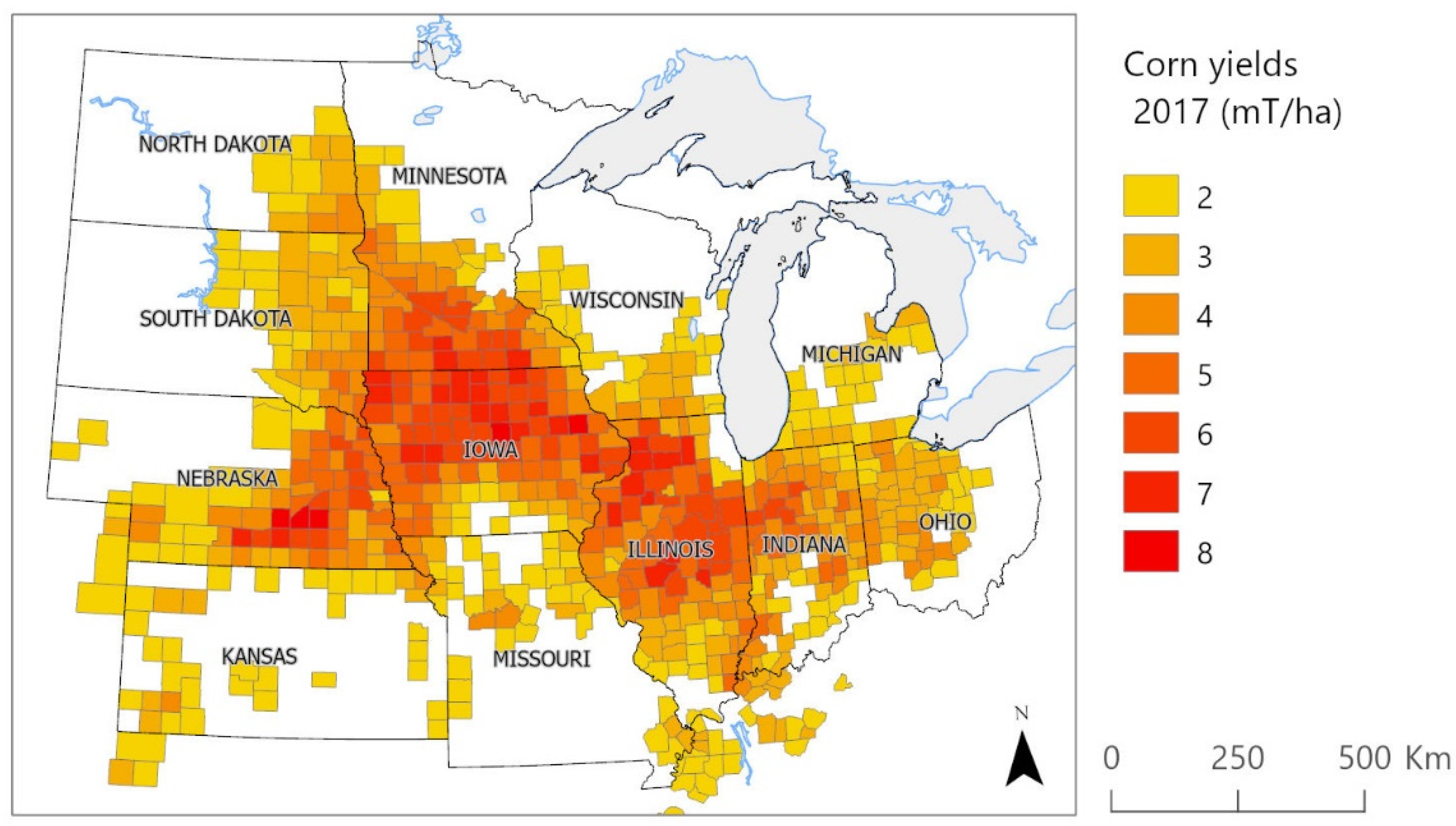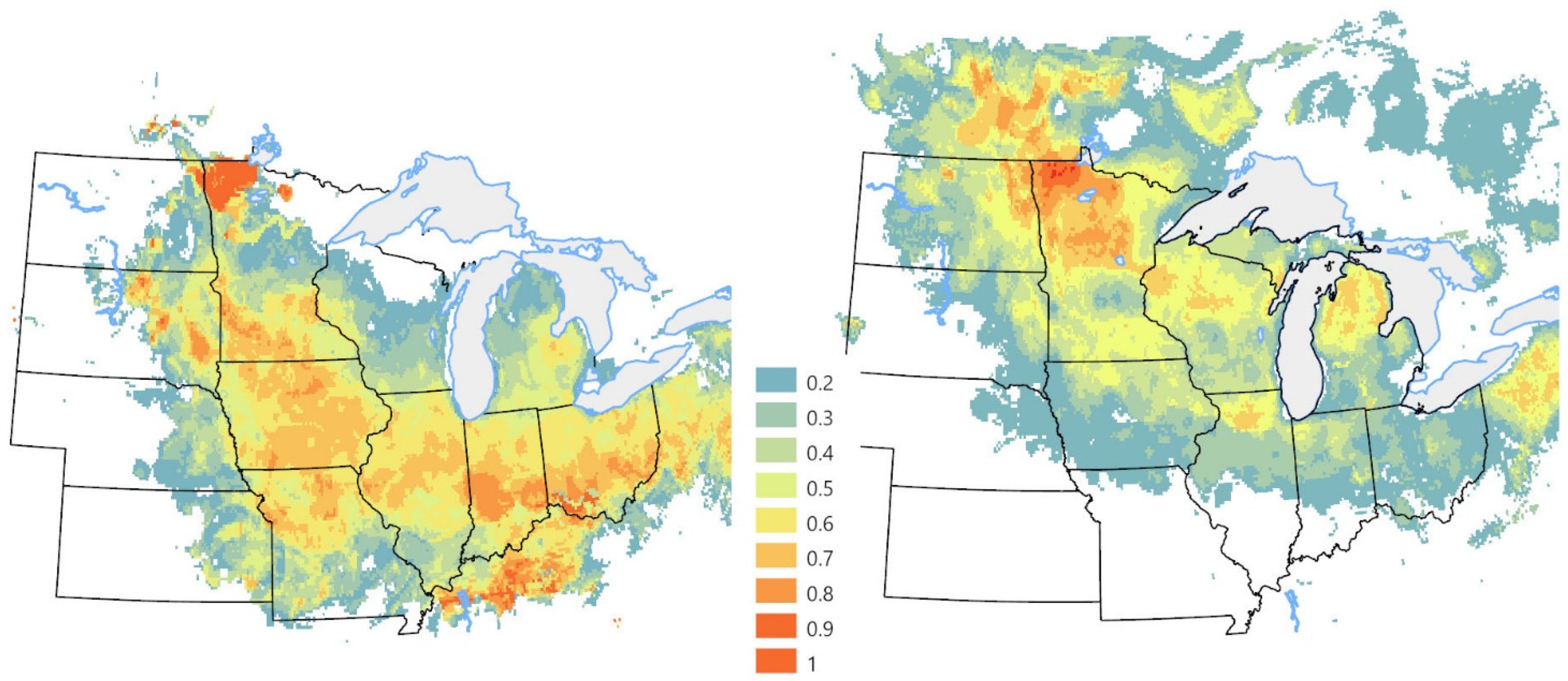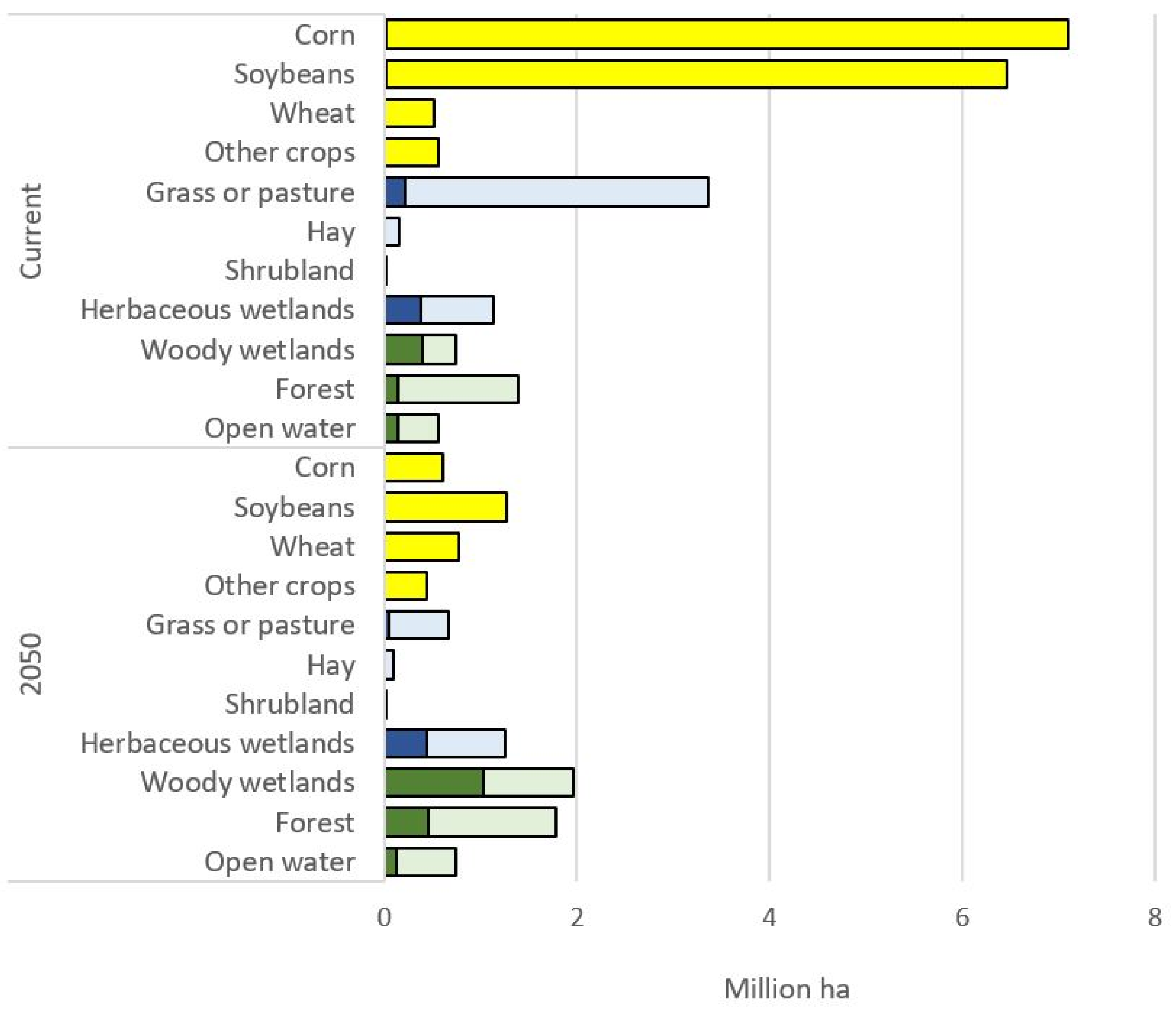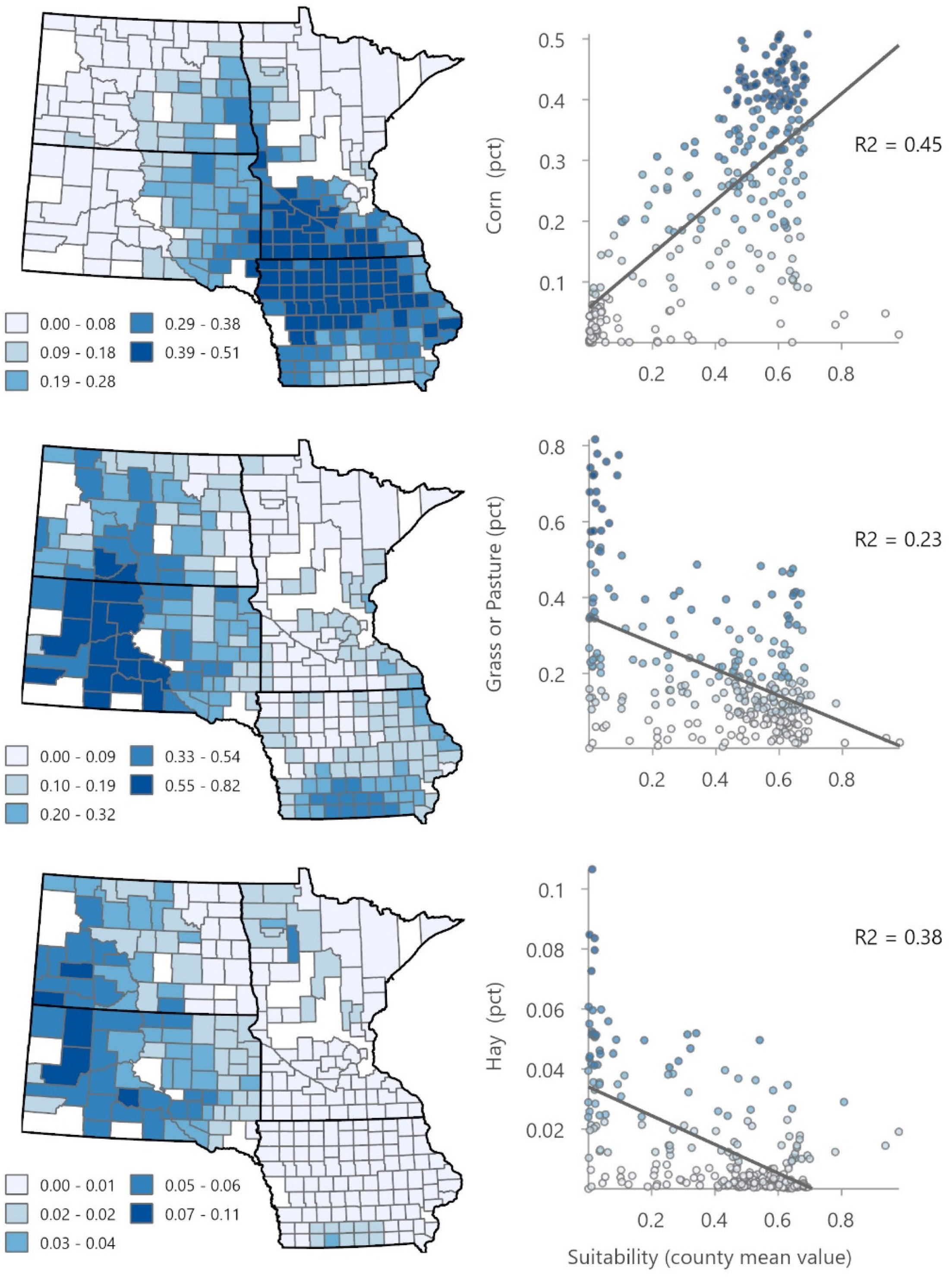Climate Change, Agriculture, and Biodiversity: How Does Shifting Agriculture Affect Habitat Availability?
Abstract
:1. Introduction
2. Materials and Methods
2.1. Study Area
2.2. Climate Suitability Modeling
2.3. Landcover Assessment
2.4. Distribution of Land Cover Classes
3. Results
3.1. Model Output and Suitability Ranges
3.2. Land Cover
3.3. Distribution of Land Cover Classes
4. Discussion
4.1. Shifting Agricultural Geographies
4.2. Biodiversity Conservation
4.3. Incentive Structures and Agricultural Production
5. Conclusions
Funding
Data Availability Statement
Conflicts of Interest
References
- Green, T.R.; Kipka, H.; David, O.; McMaster, G.S. Where is the USA Corn Belt, and how is it changing? Sci. Total Environ. 2018, 618, 1613–1618. [Google Scholar] [CrossRef] [PubMed] [Green Version]
- United States Department of Agriculture, National Agricultural Statistics Service (USDA NASS). Quick Stats. Available online: https://quickstats.nass.usda.gov/ (accessed on 16 July 2022).
- Burchfield, E.; Matthews-Pennanen, N.; Stoebner, J.; Lant, C. Changing yields in the Central United States under climate and technological change. Clim. Chang. 2019, 159, 329–346. [Google Scholar] [CrossRef]
- Liverman, D.M.; Terjung, W.H.; Hayes, J.T.; Mearns, L.O. Climatic change and grain corn yields in the North American Great Pains. Clim. Chang. 1986, 9, 327–347. [Google Scholar] [CrossRef]
- Schlenker, W.; Roberts, M.J. Nonlinear temperature effects indicate severe damages to U.S. crop yields under climate change. Proc. Natl. Acad. Sci. USA 2009, 106, 15594–15598. [Google Scholar] [CrossRef] [Green Version]
- Lobell, D.B.; Hammer, G.L.; McLean, G.; Messina, C.; Roberts, M.J.; Schlenker, W. The critical role of extreme heat for maize production in the United States. Nat. Clim. Chang. 2013, 3, 497–501. [Google Scholar] [CrossRef]
- Peterson, L.K. Impact of Climate Change on Twenty-First Century Crop Yields in the U.S. Climate 2019, 7, 40. [Google Scholar] [CrossRef] [Green Version]
- Burchfield, E.K. Shifting cultivation geographies in the Central and Eastern US. Environ. Res. Lett. 2022, 17, 054049. [Google Scholar] [CrossRef]
- Chung, U.; Sika Gbegbelegbe, S.; Shiferaw, B.; Robertson, R.; Yun, J.I.; Tesfaye, K.; Hoogenboom, G.; Sonder, K. Modeling the effect of a heat wave on maize production in the USA and its implications on food security in the developing world. Weather Clim. Extrem. 2014, 5–6, 67–77. [Google Scholar] [CrossRef] [Green Version]
- Irmak, S.; Sandhu, R.; Kukal, M.S. Multi-model projections of trade-offs between irrigated and rainfed maize yields under changing climate and future emission scenarios. Agric. Water Manag. 2022, 261, 107344. [Google Scholar] [CrossRef]
- Liang, X.-Z.; Wu, Y.; Chambers, R.G.; Schmoldt, D.L.; Gaw, W.; Liu, C.; Liu, Y.-A.; Sun, C.; Kennedy, J.A. Determining climate effects on US total agricultural productivity. Proc. Natl. Acad. Sci. USA 2017, 114, E2285–E2292. [Google Scholar] [CrossRef] [Green Version]
- Arbuckle, J.G.; Morton, L.W.; Hobbs, J. Farmer beliefs and concerns about climate change and attitudes toward adaptation and mitigation: Evidence from Iowa. Clim. Chang. 2013, 118, 551–563. [Google Scholar] [CrossRef] [Green Version]
- Gardarzi, M.; Arbuckle, J.G. Techno-optimism and farmers’ attitudes toward climate change adaptation. Environ. Behav. 2020, 52, 82–105. [Google Scholar] [CrossRef] [Green Version]
- Leiserowitz, A.; Maibach, E.; Roser-Renouf, C.; Rosenthal, S.; Cutler, M.; Kotcher, J. Politics & Global Warming, October 2017; Climate Change in the American Mind: Yale University and George Mason University; Yale Program on Climate Change Communication: New Haven, CT, USA, 2017; Available online: https://www.climatechangecommunication.org/wp-content/uploads/2017/12/Global-Warming-Policy-Politics-October-2017-min.pdf (accessed on 16 July 2022).
- Xiarchos, I.M.; Rosenfeld, J.; Kaffel, M.; Heinrich, A.; Erickson, H.; Lewandrowski, J.; Pape, D. Assessing Future Market Opportunities and Challenges for E15 and Higher Ethanol Blends. Office of the Chief Economist, USDA; 2022. Available online: https://www.usda.gov/sites/default/files/documents/e15-market-opportunities.pdf (accessed on 15 July 2022).
- Renewable Fuels Association. Zeroing in on New Opportunities: 2022 Ethanol Industry Outlook. 2022. Available online: https://ethanolrfa.org/file/2145/RFA%202022%20Outlook.pdf (accessed on 15 July 2022).
- Herkert, J.R.; Sample, D.W.; Warner, R.E. Management of Midwestern Grassland Landscapes for the Conservation of Migratory birds. In Management of Midwestern Landscapes for the Conservation of Neotropical Migratory Birds; Thompson, F.R., III, Ed.; General Technical Report NC-187; North Central Forest Experiment Station USDA Forest Service: St. Paul, MN, USA, 1995. Available online: https://www.nrs.fs.fed.us/pubs/gtr/other/gtr-nc187/index.html (accessed on 30 July 2022).
- Ballard, T.; Seager, R.; Smerdon, J.E.; Cook, B.I.; Ray, A.J.; Rajagopalan, B.; Kushnir, Y.; Nakamura, J.; Henderson, N. Hydroclimate Variability and Change in the Prairie Pothole Region, the “Duck Factory” of North America. Earth Interact. 2014, 18, 1–28. [Google Scholar] [CrossRef]
- Johnson, W.C.; Millett, B.; Gilmanov, T.; Richard, A.; Guntenspergen, G.R.; Naugle, D.E. Vulnerability of northern prairie wetlands to climate change. Bioscience 2005, 55, 863–872. [Google Scholar] [CrossRef]
- Koford, R.; Best, L.B. Managemetn of agricultural landscapes for the conservation of neotropical migratory birds. In Management of Midwestern Landscapes for the Conservation of Neotropical Migratory Birds; Thompson, F.R., III, Ed.; General Technical Report NC-187; North Central Forest Experiment Station U.S.D.A. Forest Service: St. Paul, MN, USA, 1995. Available online: https://www.nrs.fs.fed.us/pubs/gtr/other/gtr-nc187/index.html (accessed on 30 July 2022).
- Peterjohn, B.G.; Sauer, J.R. Population status of North American grassland birds from the North American Breeding Bird Survey, 1966–1996. In Ecology and Conservation of Grassland Birds of the Western Hemisphere. Studies in Avian Biology 19; Vickery, P.D., Herkert, J.R., Eds.; The University of New Mexico: Albuquerque, NM, USA, 1999; pp. 27–44. [Google Scholar]
- United States Department of Agriculture Natural Resources Conservation Service (NRCS). The Conservation Reserve Program Enhances Landscape-Level Grassland Bird Species Richness. CEAP Conservation Insights (January 2009); 2009. Available online: https://www.nrcs.usda.gov/Internet/FSE_DOCUMENTS/stelprdb1041738.pdf (accessed on 15 July 2022).
- Griscom, B.W.; Adams, J.; Ellis, P.W.; Houghton, R.A.; Lomax, G.; Miteva, D.A.; Schlesinger, W.H.; Shoch, D.; Siikamäki, J.V.; Smith, P.; et al. Natural climate solutions. Proc. Natl. Acad. Sci. USA 2017, 114, 11645–11650. [Google Scholar] [CrossRef] [PubMed] [Green Version]
- Tollefsen, J. Global deal for nature fleshed out with specific conservation goals. Nature 2019. [Google Scholar] [CrossRef]
- Sodhi, N.S.; Koh, L.P.; Clements, R.; Wanger, T.C.; Hill, J.K.; Hamer, K.C.; Clough, Y.; Tscharntke, T.; Posa, M.R.; Lee, T.M. Conserving Southeast Asian forest biodiversity in human-modified landscapes. Biol. Conserv. 2010, 143, 2375–2384. [Google Scholar] [CrossRef]
- Pellikka, P.; Clark, B.; Gonsamo Gosa, A.; Himberg, N.; Hurskainen, P.; Maeda, E.E.; Mwang´ombe, J.; Omoro, L.; Siljander, M. Agricultural Expansion and Its Consequences in the Taita Hills, Kenya. In Kenya: A Natural Outlook: Geo-Environmental Resources and Hazards. Developments in Earth Surface Processes, No. 16; Paron, P., Ochieng Olago, D., Thine Omuto, C., Eds.; North-Holland Pub. Co.: Amsterdam, The Netherlands, 2010; pp. 165–179. [Google Scholar] [CrossRef] [Green Version]
- Rasche, L.; Habel, J.C.; Stork, N.; Schmid, E.; Schneider, U.A. Food versus wildlife: Will biodiversity hotspots benefit from healthier diets? Glob. Ecol. Biogeogr. 2022, 31, 1090–1103. [Google Scholar] [CrossRef]
- Poore, J.; Nemecek, T. Reducing food's environmental impacts through producers and consumers. Science 2018, 360, 987–992. [Google Scholar] [CrossRef] [Green Version]
- Masood, E. The battle for the soul of biodiversity: An ideological clash could undermine a crucial assessment of the world’s disappearing plant and animal life. Nature 2018, 560, 423–425. [Google Scholar] [CrossRef] [Green Version]
- Igl, L.D.; Johnson, D.H. Changes in breeding bird populations in North Dakota: 1967 to 1992–1993. Auk 1997, 114, 74–92. [Google Scholar] [CrossRef] [Green Version]
- Cunningham, M.A. A comparison of public lands and farmlands for grassland bird conservation. Prof. Geogr. 2005, 57, 51–65. [Google Scholar]
- Johnson, D.H. Management of northern prairies and wetlands for the conservation of neotropical migratory birds. In Management of Midwestern Landscapes for the Conservation of Neotropical Migratory Birds; Thompson, F.R., III, Ed.; U.S.D.A. Forest Service General Technical Report NC-187; North Central Forest Experiment Station: St. Paul, MN, USA, 1996; pp. 53–67. [Google Scholar]
- Knopf, F.L. Avian assemblages on altered grasslands. In A Century of Avifaunal Change in Western North America. Studies in Avian Biology 15; Cooper Ornithological Society: Norman, CA, USA, 1994; pp. 247–257. [Google Scholar]
- Schulte, L.A.; Niemi, J.; Helmers, M.J.; Liebman, M.; Arbuckle, J.G.; James, D.E.; Kolka, R.K.; O’Neal, M.E.; Tomer, M.D.; Tyndall, J.C.; et al. Prairie strips improve biodiversity and the delivery of multiple ecosystem services from corn–soybean croplands. Proc. Natl. Acad. Sci. USA 2017, 114, 11247–11252. [Google Scholar] [CrossRef] [PubMed] [Green Version]
- Wright, C.K.; Larson, B.; Lark, T.J.; Gibbs, H.K. Recent grassland losses are concentrated around U.S. ethanol refineries. Environ. Res. Lett. 2017, 12, 44001. [Google Scholar] [CrossRef]
- Chen, X.; Khanna, M. Effect of corn ethanol production on Conservation Reserve Program acres in the US. Appl. Energy 2018, 225, 124–134. [Google Scholar] [CrossRef] [Green Version]
- Alemu, W.G.; Henebry, G.M.; Melesse, A.F. Land Cover and Land Use Change in the US Prairie Pothole Region Using the USD A Cropland Data Layer. Land 2020, 9, 165. [Google Scholar] [CrossRef]
- Phillips, S.J.; Anderson, R.P.; Schapire, R.E. Maximum Entropy Modeling of Species Geographic Distributions. Ecol. Model. 2006, 190, 231–259. [Google Scholar] [CrossRef] [Green Version]
- Evangelista, P.; Young, N.; Burnett, J. How Will Climate Change Spatially Affect Agriculture Production in Ethiopia? Case Studies of Important Cereal Crops. Clim. Chang. 2013, 119, 855–873. [Google Scholar] [CrossRef]
- Kogo, B.K.; Kumar, L.; Koech, R.; Kariyawasam, C.S. Modelling Climate Suitability for Rainfed Maize Cultivation in Kenya Using a Maximum Entropy (MaxENT) Approach. Agronomy 2019, 9, 727. [Google Scholar] [CrossRef] [Green Version]
- Akpoti, K.; Kabo-bah, A.T.; Dossou-Yovo, E.R.; Groen, T.A.; Zwart, S.J. Mapping Suitability for Rice Production in Inland Valley Landscapes in Benin and Togo Using Environmental Niche Modeling. Sci. Total Environ. 2020, 709, 136165. [Google Scholar] [CrossRef]
- Cunningham, M.; Wright, N.; Mort Ranta, P.; Benton, H.; Ragy, H.; Edington, J.; Kellner, C. Mapping Vulnerability of Cotton to Climate Change in West Africa: Challenges for Sustainable Development. Climate 2021, 9, 68. [Google Scholar] [CrossRef]
- Hijmans, R.J.; Cameron, S.E.; Parra, J.L.; Jones, P.G.; Jarvis, A. Very high resolution interpolated climate surfaces for global land areas. Int. J. Climatol. 2005, 25, 1965–1978. [Google Scholar] [CrossRef]
- USDA National Agricultural Statistics Service, 2017 Census of Agriculture (Released 2019). Complete Data. Available online: www.nass.usda.gov/AgCensus (accessed on 15 July 2022).
- Fick, S.E.; Hijmans, R.J. WorldClim 2: New 1km spatial resolution climate surfaces for global land areas. Int. J. Climatol. 2017, 37, 4302–4315. [Google Scholar] [CrossRef]
- Hijmans, R.J.; Elith, J. Spatial Distribution Modeling. 2019. Available online: https://rspatial.org/raster/sdm/SDM.pdf (accessed on 15 July 2022).
- Elith, J.; Phillips, S.J.; Hastie, T.; Dudík, M.; Chee, Y.E.; Yates, C.J. A statistical explanation of MaxEnt for ecologists. Divers. Distrib. 2011, 17, 43–57. [Google Scholar] [CrossRef]
- Merow, C.; Smith, M.J.; Silander, J.A. A Practical Guide to MaxEnt for Modeling Species’ Distributions: What It Does, and Why Inputs and Settings Matter. Ecography 2013, 36, 1058–1069. [Google Scholar] [CrossRef]
- Intergovernmental Panel on Climate Change (IPCC). Summary for Policymakers. In Climate Change 2013: The Physical Science Basis; Contribution of Working Group I to the Fifth Assessment Report of the Intergovernmental Panel on Climate Change; Cambridge University Press: Cambridge, UK; New York, NY, USA, 2013. [Google Scholar]
- Schwalm, C.R.; Glendon, S.; Duffy, P.B. RCP8.5 Tracks Cumulative CO2 Emissions. Proc. Natl. Acad. Sci. USA 2020, 117, 19656–19657. [Google Scholar] [CrossRef]
- Navarro-Racines, C.; Tarapues, J.; Thornton, P.; Jarvis, A.; Ramirez-Villegas, J. High-Resolution and Bias-Corrected CMIP5 Projections for Climate Change Impact Assessments. Sci. Data 2020, 7, 7. [Google Scholar] [CrossRef] [Green Version]
- Hallgren, W.; Beaumont, L.; Bowness, A.; Chambers, L.; Graham, E.; Holewa, H.; Laffan, S.; Mackey, B.; Nix, H.; Price, J.; et al. The Biodiversity and Climate Change Virtual Laboratory: Where ecology meets big data. Environ. Model. Softw. 2016, 76, 182–186. [Google Scholar] [CrossRef] [Green Version]
- Allouche, O.; Tsoar, A.; Kadmon, R. Assessing the Accuracy of Species Distribution Models: Prevalence, Kappa and the True Skill Statistic (TSS): Assessing the Accuracy of Distribution Models. J. Appl. Ecol. 2006, 43, 1223–1232. [Google Scholar] [CrossRef]
- Han, W.; Yang, Z.; Di, L.; Yue, P. A geospatial Web service approach for creating on-demand Cropland Data Layer thematic maps. Trans. ASABE 2014, 57, 239–247. [Google Scholar] [CrossRef]
- Esri Inc. ArcGIS Pro, Version 2.9; Esri Inc.: Redlands, CA, USA, 2021. Available online: https://www.esri.com/ (accessed on 15 July 2022).
- U.S. Geological Survey (USGS) Gap Analysis Project (GAP) (a). Protected Areas Database of the United States (PAD-US) 2.1: U.S. Geological Survey Data Release. 2020. Available online: https://doi.org/10.5066/P92QM3NT (accessed on 15 July 2022).
- Iowa Corn Growers. Corn Facts. Available online: https://www.iowacorn.org/media-page/corn-facts (accessed on 15 July 2022).
- Pimentel, D. Ethanol Fuels: Energy Balance, Economics, and Environmental Impacts are Negative. Nat. Resour. Res. 2003, 12, 127–134. [Google Scholar] [CrossRef]
- Pontecorvo, E. A Midwest pipeline promises to return carbon dioxide to the ground. Grist 2021. Available online: https://grist.org/energy/a-midwest-pipeline-promises-to-return-carbon-dioxide-to-the-ground/ (accessed on 15 July 2022).




| Land Cover | Current | 2050 | ||
|---|---|---|---|---|
| Protected | Not | Protected | Not | |
| All | 6 | 94 | 22 | 78 |
| Shrubland | 17 | 83 | 20 | 80 |
| Hay | 2 | 98 | 2 | 98 |
| Grass or pasture | 6 | 94 | 7 | 93 |
| Herbaceous wetlands | 33 | 67 | 35 | 65 |
| Woody wetlands | 53 | 47 | 52 | 48 |
| Open water | 26 | 74 | 17 | 83 |
| Forest | 10 | 90 | 25 | 75 |
| Wheat | 0 | 100 | 0 | 100 |
| Other crops | 1 | 99 | 1 | 99 |
| Soybeans | 0 | 100 | 1 | 99 |
| Corn | 0 | 100 | 0 | 100 |
Publisher’s Note: MDPI stays neutral with regard to jurisdictional claims in published maps and institutional affiliations. |
© 2022 by the author. Licensee MDPI, Basel, Switzerland. This article is an open access article distributed under the terms and conditions of the Creative Commons Attribution (CC BY) license (https://creativecommons.org/licenses/by/4.0/).
Share and Cite
Cunningham, M.A. Climate Change, Agriculture, and Biodiversity: How Does Shifting Agriculture Affect Habitat Availability? Land 2022, 11, 1257. https://doi.org/10.3390/land11081257
Cunningham MA. Climate Change, Agriculture, and Biodiversity: How Does Shifting Agriculture Affect Habitat Availability? Land. 2022; 11(8):1257. https://doi.org/10.3390/land11081257
Chicago/Turabian StyleCunningham, Mary Ann. 2022. "Climate Change, Agriculture, and Biodiversity: How Does Shifting Agriculture Affect Habitat Availability?" Land 11, no. 8: 1257. https://doi.org/10.3390/land11081257
APA StyleCunningham, M. A. (2022). Climate Change, Agriculture, and Biodiversity: How Does Shifting Agriculture Affect Habitat Availability? Land, 11(8), 1257. https://doi.org/10.3390/land11081257






